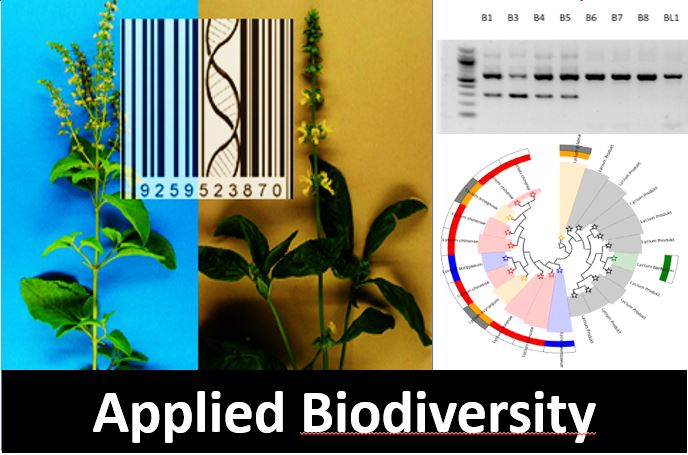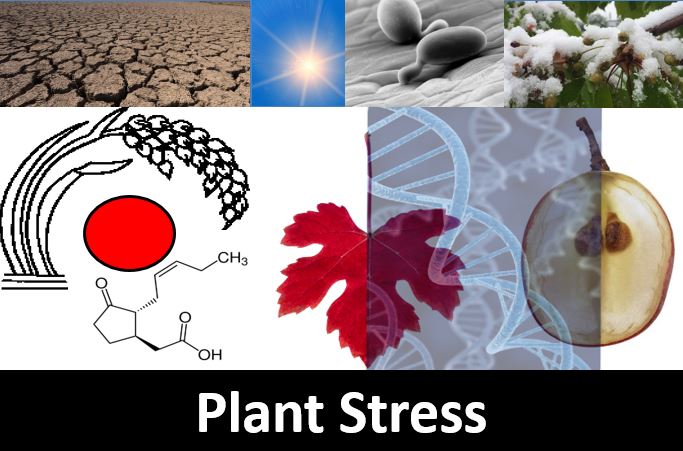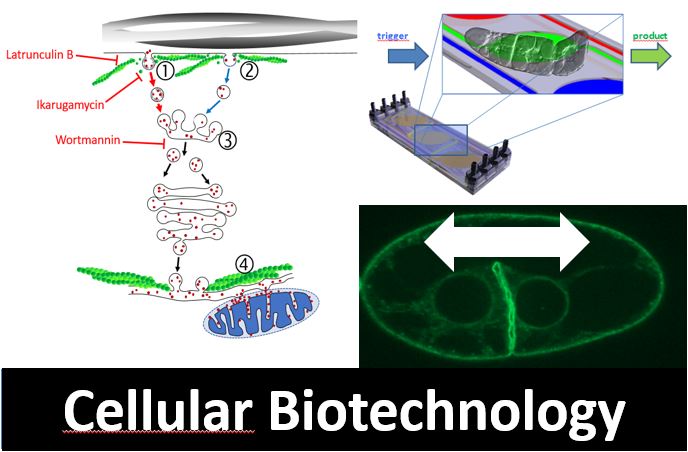News ticker
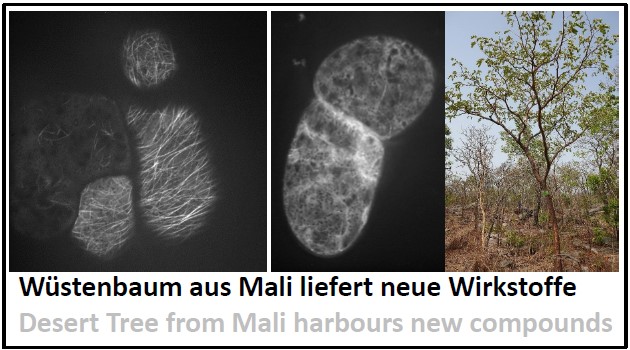 |
Tumour Compound from a Mali Desert TreeThe use of plants for healing accompanied humans from their very beginnings. Among the almost half a million of species that have already been described, there are many that produce unique compounds. Especially in developing countries many people depend on plants for healing, because they cannot afford the expensive Western style medication. The tree Detarium microcarpum growing in Mali is used in traditional medicine also against breast cancer. Many anti-tumour compounds target the microtubules, which blocks the proliferation of cancer cells. We, therefore, investigated, whether this is the case for this medicinal plant from Mali. Using tobacco cells, where microtubules were labelled by a fluorescent protein, and could demonstrate that, indeed, extracts from D. microcarpum eliminated microtubules swiftly and efficiently. The effect could be localised to the alkaloid fraction. On this base it will be possible to identify the active compound in the future, not only to develop novel tumour therapies, but also to lift traditional medicine by scientific grounding on a higher level.
Publication
Dembele N, Nick P (2024) Anti‐microtubular activity of total alkaloids and aqueous extract of Detarium microcarpum a medicinal plant harvested in Mali. Protoplasma 262, 415-430 - pdf
|
|
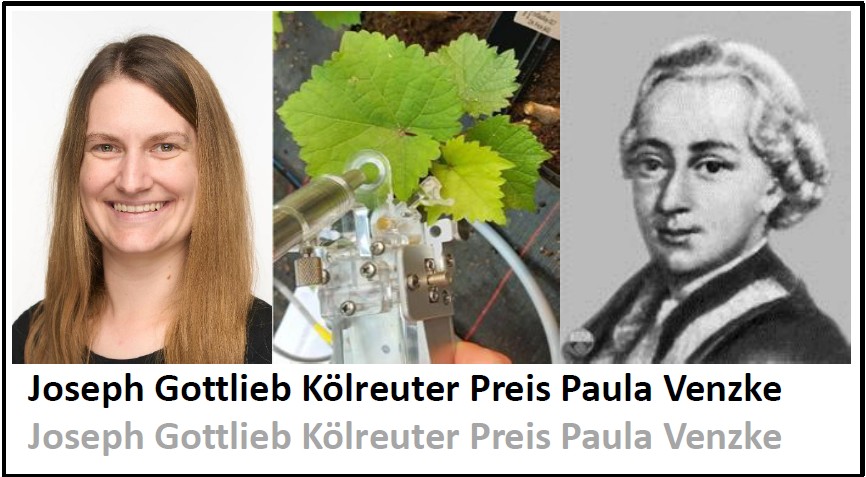 |
Joseph Gottlieb Kölreuter Award for Paula VenzkeSince 2021, the association Friends of the Botanic Garden at the KIT, announces the Joseph Gottlieb Kölreuter Award for Sustainability. It is dedicated for theses in the field of plant sciences that contribute to sustainability in agriculture, or nature and environmental conservation. This year it was Paula Venzke, who did her master thesis with us an with our partners at the IBMP in Strasbourg. Topic was climate change in viticulture. How can we cope the challenge of progressively hot summers by breeding novel KliWi varieties (for Klima-Widerstandsfähig, climate resilient)? How can we determine the climate resilience of current varieties on a scientific base? Paula Venzke conducted controlled heat-stress experiments at the JKIP Experimental Station and developed non-invasive techniques to monitor the physiological responses of grapevine. She could demonstrate that the popular variety Riesling has to buffer heat stress by opening its stomata, thus, losing a lot of water. In contrast, the wild grapevine Hördt 29 originating from the alluvial forests of the Old Rhine can tolerate higher leaf temperatures, such that it can economise the use of water. This work led to new insights and new methods to evaluate heat tolerance on a scientific base, also an important contribution for our Interreg Upper Rhine projekt Kliwiresse. Congratulations! |
|
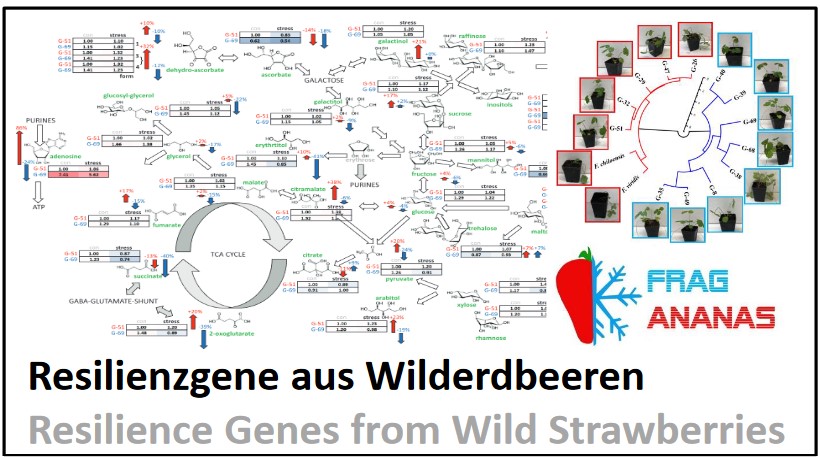 |
Cold Resilience from the Black ForestClimate change is more than heat stress. The blurred seasonality means often untimely cold snaps. For the strawberry production in the Mediterranean this is turning progressively problematic. However, nature offers solutions - we just need to sustain and valorise its diversity. This was the idea behind the Gene Bank for Crop Wild Relatives initiated a bit more than a decade ago by the Federal Ministry of Agriculture. Here, we were in charge for the Southwest of Germany. In frame of the project Fragananas, funded by the Federal Ministry of Research, we collaborated with partners in Egypt and were able to find some "tough guys" among German wild strawberries and use them to understand the basis of cold tolerance. A especially potent variant of the gene switch Cold Box Factor 4 induces a strong accumulation of the antifreeze protein Xero 2. With the help of the metabolomcis platform of Dr. Weinert at the Max-Rubner-Institute it was then possible to find metabolic changes that mediate cold tolerance, for instance the induction of tyrosol, the signal compound gamma butyric acid, or the accumulation of the amino acid proline. These findings do not only allow to predict the cold tolerance of strawberry, but also to improve it by introgression of the wild genes. Publication 209. Kanbar A, Weinert CH, Kottutz D, La Th, Abuslima E, Kabil F, Hazman M, Egert B, Trierweiler B, Kulling SE, Nick P (2024) Cold Tolerance of Woodland Strawberry (Fragaria vesca) is linked to Cold Box Factor 4 Cold and the dehydrin Xero2. J Exp Bot 75, 5857-5879 - pdf |
|
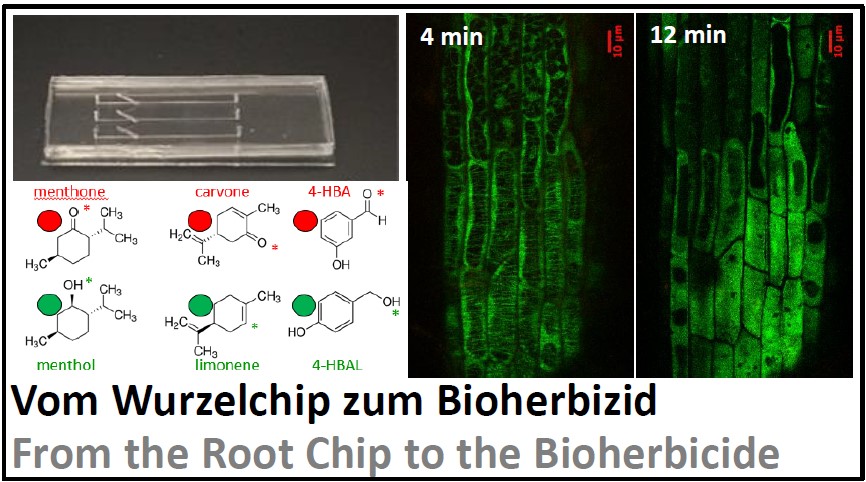 |
From the Root Chip to the BioherbicidePlants have sly old ears. An estimated million compounds occur only in plants and have the task to convince other life forms to do work for plants. Often, cellular signalling is hijacked. We humans are no exception – whether it is caffeine, opium, or Cannabis, specific plant compounds play tricks to our neural system. One particular weird case of plant manipulation could now be uncovered. Our Mints beat competitors by a „Deathly After Eight“. Why does this not damage the sender himself – here the compounds are most abundant? Using Spearmint as paradigm, we could demonstrate that the scent, carvone, persuades root cells of the target to dissolve its microtubules and initiate a ritual form of suicide. Changing minute details on fhte molecule eliminates this effect. Thus, carvone is not a poison, but a persuasive signal. Obviously, this signal can bind to a specific receptor that otherwise has the task to ward off microbial attacks. In that context, cellular suicide makes perfectly sense. By its sacrifice, the infected cell kills the intruder and protects the others. We suspect that Mints have modified their own receptor, such that carvone cannot bind. Signals that eliminate competitors – this has, of course, considerable potential for the development of novel bioherbicides. In the next step we want to find out, who listens to the signal and identify the receptor. Schritt wollen wir nun herausfinden, wer auf dieses Signal hört. This sophisticated strategy could be uncovered by our project DialogProTec (Science Offensive of Interreg Upper Rhine) during an interdisciplinary cooperation with partners at the Campus North IMT, Université de Strasbourg, the Institute for Biological Agents in Kaiserslautern, the University of Freiburg, and the Research Institute for biological Agriculture in Frick and publish in the Journal of Experimental Botany. Publication 210. Hering N, Schmit AC, Herzog E, Corbin LT, Schmidt-Speicher L, Ahrens R, Fauconnier ML, Nick P (2024) Spearmint Targets Microtubules by (−)-Carvone. Hort Res. doi.org/10.1093/hr/uhae151 - pdf
|
|
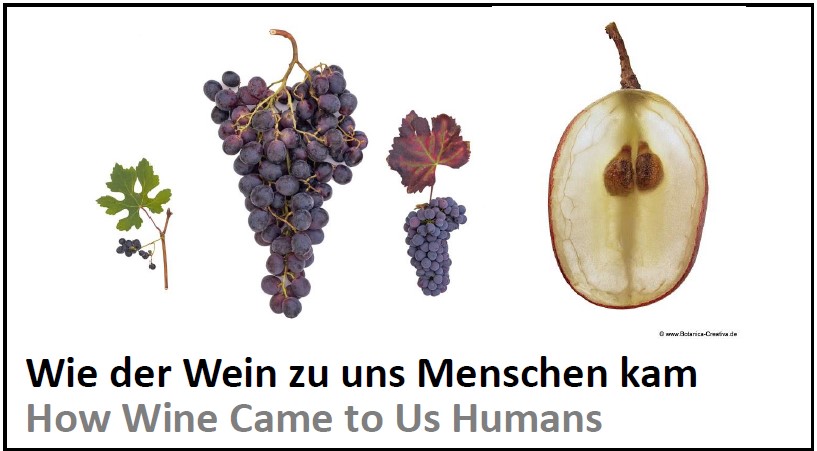 |
The Origin of GrapevineFour years of hard work, almost 4000 genomes - the fruit of this effort has now been published in Science. The Wild Grapevine Collection of the KIT had an important role here. It could be shown that Grapevine was domesticated twice independently, once in the Caucasus to produce wine, a second time in the Near East to get table grapes. During its migration to the West, there were numerous love affairs with local wild grapevines, giving rise to the large diversity of grapevines. This project joined people from 16 countries, despite sometimes difficult political circumstances and allows a deep look into the complex history of this crop plant that not only founded civilisations, but was also one of the first globally traded goods, breaching the borders of geography, language, and religion. The treasure of knowledge generated in this project has not even been scratched - during the time, when grapevine, by an interplay between climatic disruptions and human migration, conquered many regions, it collected genes that help to cope with adverse conditions. These genes can help now to safeguard viticulture against the consequences of climate change - this is exactly, what we do now in our Interreg Upper Rhine project Kliwiresse. Seminar as part of the Saturday University Freiburg. Interview with the Washington Post Youtube on the impact of the project for the region
|
|
|
|
||
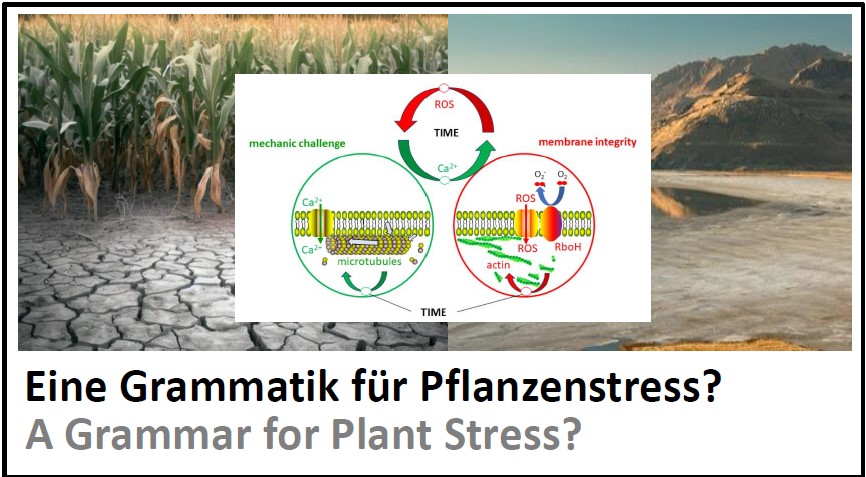 |
How Can Plants Distinguish Stress Qualities?Plants cannot run away, when they do not like their environment. They need to adapt. The ability to recognise and to appropriately respond to challenges is, thus, the central strategy for plant survival. We need to understand this as to prepare for climate change. Meanwhile, this has reached public consciousness. However, it is mostly unclear, how plant distinguish stress qualities. When different stresses act in concert, they even have to render decisions. This happens, for instance, during a hot summer day - shall the leaves be cooled by transpiration, or shall the water rather be saved up to get through an ensuing drought? How can plants decide without a brain? For us, this world is so strange that we do not understand it. Here, our new concept starts - in brief, we propose that there are a handful of signals that mean, by recombination, different qualities of stress and, therefore, evoke different responses. Actually quite comparable to human language - the "words" are these signalling molecules, the "grammar" is their temporal sequence and combination. Using concrete examples we demonstrate that this idea works and develop its evolutionary context. While this concept may appear unusual, it leads to clear implications that can be tested experimentally, and it yields explanations to explain the complex stress responses of plants. Publication [63] Nick P (2023) Towards a Grammar of Plant Stress – Modular Signalling Conveys Meaning. Theor Exp Plant Physiol. doi 10.1007/s40626-023-00292-2 - pdf |
|
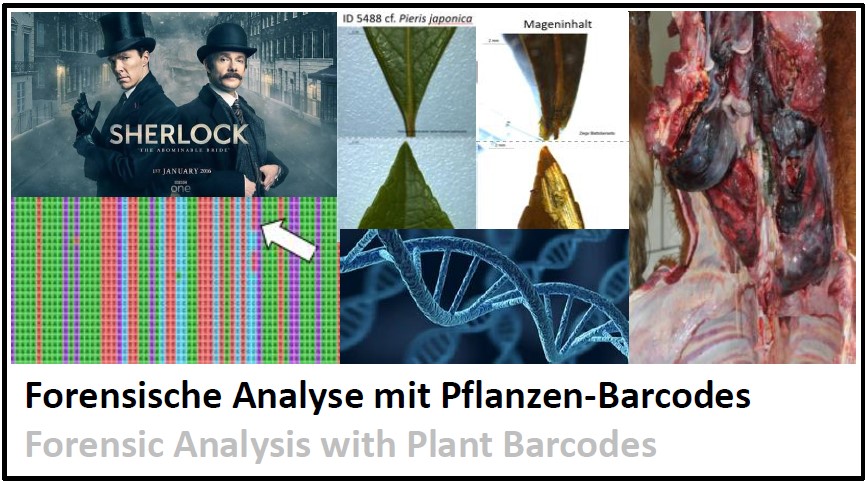 |
Genetic Barcodes Crack Forensic EnigmaSince many years, we work on methods to unveil fake and surrogation of plant-based food, but also medicinal products using so-called DNA barcods. Our taxonomically carefully identified and developed collection of reference plants in the JKIP Experimental Station at the Adenauerring has been crucial to this work. Our work is often thematised in the media, just recently in a broadcast of the Hessische Rundfunk on Superfood that was then also shown by NDR, WDR, ARD and MDR (see video...). This echo has induced interest from those institutions that in Germany are in charge of food safety. Here, we obtained, in the middle of the Corona period, an unusual request by the Chemical Veterinary Investigation Office in Freiburg - they had to deal with several cases of animal poisoning, whether we could support them? We could - using a combination of microscopic diagnostics and DNA barcoding we could solve all cases. The usual method, where species are assigned through a statistic value of sequence similarity, was refined for this purpose. We used (statistically ignored) specific sequence motifs as genetic fingerprints - this approach is known in evolution research as homology by specific quality. This forensic study has now been published in PloS ONE: 204. Schweikle S, Häser A, Wetters S, Raisin M, Greiner M, Fischer U, Pietsch K, Suntz M, Nick P (2023) DNA barcoding as new diagnostic tool to lethal plant poisoning in herbivorous mammals. PloS ONE 18, e0292275 - pdf |
|
↵
↵

